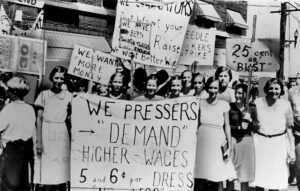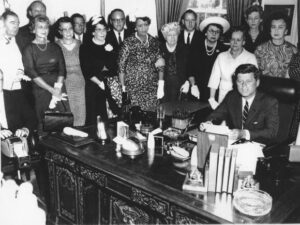- U.S. parents financially support their adult children. But in immigrant families, it’s the reverse.Brief report from CCF Early Career Scholar Dr. Vanessa Delgado shows that parental immigration status shapes adult children’s decisions to “give back” in immigrant families.
- Work-Family Stressors, Gender, and Mental Health during COVID-19 and BeyondA briefing paper prepared by Daniel L. Carson, University of Utah, and Melissa A. Milkie, University of Toronto, for the Council on Contemporary Families symposium The COVID-19 Pandemic and the… Read more: Work-Family Stressors, Gender, and Mental Health during COVID-19 and Beyond
- Leave Laws Support EquityA briefing paper prepared by Jeff Hayes, Women’s Bureau, U.S. Department of Labor[1], and H. Elizabeth Peters, Urban Institute, for the Council on Contemporary Families symposium The COVID-19 Pandemic and… Read more: Leave Laws Support Equity
- Dads Home with Kids Peaked During The COVID-19 Pandemic – But Not for The Reason You ThinkA briefing paper prepared by Arielle Kuperberg, University of North Carolina – Greensboro, Sarah Thébaud, University of California, Santa Barbara, Kathleen Gerson, New York University, and Brad Harrington, Boston College,… Read more: Dads Home with Kids Peaked During The COVID-19 Pandemic – But Not for The Reason You Think
- Can Remote Work Fuel Gender Equality? Evidence Shows Cause for Optimism but Challenges RemainA briefing paper prepared by Wen Fan, Boston University, and Richard J. Petts, Ball State University, for the Council on Contemporary Families symposium The COVID-19 Pandemic and the Future of… Read more: Can Remote Work Fuel Gender Equality? Evidence Shows Cause for Optimism but Challenges Remain
- Mothers Continue to Experience Career Consequences Three Years into the PandemicA briefing paper prepared by Jill E. Yavorsky, University of North Carolina Charlotte, Yue Qian, University of British Columbia, and Liana Christin Landivar, Women’s Bureau, U.S. Department of Labor, for… Read more: Mothers Continue to Experience Career Consequences Three Years into the Pandemic
- Executive Summary: The COVID-19 Pandemic and the Future of Gender EqualityPrepared by Daniel L. Carlson, University of Utah, and Richard J. Petts, Ball State University, for the Council on Contemporary Families symposium The COVID-19 Pandemic and the Future of Gender… Read more: Executive Summary: The COVID-19 Pandemic and the Future of Gender Equality
- The COVID-19 Pandemic and the Future of Gender Equality SymposiumA new CCF symposium highlights what emerging research tells us about changes to family & work life during the COVID-19 pandemic and what they mean for the future of gender equality in the U.S.
- Between A Rock and A Hard Place: Lessons From The Covid-19 Pandemic About Health Concerns And US Mothers’ EmploymentNew research on how mothers’ concerns about community COVID-19 transmission affects their labor force participation.
- Mine and Yours, or Ours: Are All Egalitarian Relationships Equal?It turns out there is a big difference between dividing up the tasks so that each partner does different ones versus sharing or alternating the same tasks, so that partners contribute equally to each.
- Mothers Are the Primary Earners in Growing Numbers of Families with ChildrenA new study estimates that about 70% of U.S. moms can expect to be primary financial providers before their children turn 18.
- Why Families Need More Financial Support during the COVID-19 PandemicDespite the important temporary relief provided to many families by the March 2020 CARES Act, millions of American families are experiencing financial hardship as we enter the new year.
- CCF’s Stephanie Coontz on Paying Stay-at-Home Parents in The New York TimesIn a recent article for the New York Times, CCF Director of Research and Public Education Stephanie Coontz discusses the potential implications of paying stay-at-home parents, a role most often… Read more: CCF’s Stephanie Coontz on Paying Stay-at-Home Parents in The New York Times
- Parents Can’t Go It Alone–They Never Have: What to Do for Parents to Help Our Next GenerationParents Can’t Go It Alone introduces you to important new work about what parents need to meet their goals and successfully raise the next generation.
- Why No One Can “Have It All” and What to Do About ItA briefing paper prepared by Kathleen Gerson, New York University, for the Council on Contemporary Families’ Symposium Parents Can’t Go It Alone—They Never Have. If debates about women’s rights, relationships… Read more: Why No One Can “Have It All” and What to Do About It
- New from CCF: Even Gender Inequality is UnequalFOR IMMEDIATE RELEASE CONTACT: Virginia Rutter / Sociology @ Framingham State University vrutter@gmail.com Sociologist Jill Yavorsky conducted a field audit on gender discrimination in hiring and shares this early exclusive… Read more: New from CCF: Even Gender Inequality is Unequal
- Hiring-related Discrimination: Sexist Beliefs and Expectations Hurt both Women’s and Men’s Career OptionsHiring-related Discrimination: Sexist Beliefs and Expectations Hurt both Women’s and Men’s Career Options A briefing paper prepared for the Council on Contemporary Families by Jill Yavorsky, Assistant Professor of Sociology… Read more: Hiring-related Discrimination: Sexist Beliefs and Expectations Hurt both Women’s and Men’s Career Options
- Three Q: Per Coontz, Equality Is an agenda for all working people, not just feminists.3q: Per Coontz, Equality is an Agenda for All Working People, Not Just Feminists Virginia Rutter interviews Stephanie Coontz on the new Council on Contemporary Families brief, Hiring-related Discrimination: Sexist… Read more: Three Q: Per Coontz, Equality Is an agenda for all working people, not just feminists.
- TANF didn’t fight poverty. Full employment did.A briefing paper prepared for Council on Contemporary Families by Alan Barber, Director of Domestic Policy, Center for Economic and Policy Research, and Virginia Rutter, Professor of Sociology, Framingham State… Read more: TANF didn’t fight poverty. Full employment did.
- What Helps Women Entrepreneurs Flourish?What Helps Women Entrepreneurs Flourish? A briefing paper prepared for the Council on Contemporary Families by Sarah Thébaud, University of California at Santa Barbara November 5, 2015 Most Americans agree… Read more: What Helps Women Entrepreneurs Flourish?
- Brief: Back on Track? The Stall and Rebound in Support for Women’s New Roles in Work and Politics, 1977-2012Six charts demonstrate a renewed progress towards gender equality starting around 2006.
- CCF Research Brief: Really? Work lowers people’s stress levelsNational surveys and other studies continuously tell us that work is a major source of stress for Americans. But this study has found that people have significantly lower levels of stress at work than at home. These low levels of cortisol may help explain a long-standing finding that has always been hard to reconcile with the idea that work is a major source of stress: People who work have better mental and physical health than their non-working peers.
- CCF Civil Rights Symposium: Women’s Changing Social Status since the Civil Rights ActToday the Council on Contemporary Families releases the third set of papers in a three part symposium marking the 50th anniversary of the Civil Rights Act. The first two sets of papers described changes in America’s religious and racial-ethnic landscape in the half century since it became illegal to discriminate on the basis of religion, skin color, national origin, race, ethnicity or gender.
- CCF Equal Pay Symposium: 50 Years Since the Equal Pay Act of 1963Fifty years ago this week, on June 10, 1963, President John F. Kennedy signed the Equal Pay Act, amending the earlier Fair Labor Standards Act of 1938, to “prohibit discrimination on account of sex in the payment of wages by employers.” So, how’s that going?
- Gender Bias and the Fight for Equal PayBy Sheryl Sandberg Chief Operating Officer, Facebook and Founder, www.leanin.org For more information, or to arrange an interview, contact Andrea Saul: press@leanin.org In 1947, Anita Summers, the mother of my… Read more: Gender Bias and the Fight for Equal Pay
- Which Policies Promote Gender Pay Equality?By Joya Misra Professor of Sociology & Public Policy University of Massachusetts, Amherst misra@soc.umass.edu; 413-545-5969 Why do women earn less than men? Research points to a number of different explanations,… Read more: Which Policies Promote Gender Pay Equality?
- Happy Birthday Equal Pay: Pregnancy Accommodation as the New FrontierBy Joan C. Williams, Director of the Center for WorkLife Law, Hastings Foundation Chair, University of California, Hastings College of the Law williams@uchastings.edu; (415) 565-4706 Key pieces of legislation passed… Read more: Happy Birthday Equal Pay: Pregnancy Accommodation as the New Frontier
- The Wrong Route to Equality: Men’s Declining WagesBy Heidi Shierholz Labor Market Economist Economic Policy Institute, Washington, DC hshierholz@epi.org, (202) 775-8810 In the late 1970s, after a long period of holding fairly steady, the gap in wages… Read more: The Wrong Route to Equality: Men’s Declining Wages
- Equal Pay? Not Yet for MothersBy Shelley J. Correll Professor of Sociology Director Clayman Institute for Gender Research Stanford University scorrell@stanford.edu; 650-721-1736 Last month, hedge fund billionaire Paul Tudor Jones set off a controversy when he… Read more: Equal Pay? Not Yet for Mothers
- Men against Women, or the Top 20 Percent against the Bottom 80?By Leslie McCall Professor of Sociology and Political Science Faculty Fellow, Institute for Policy Research Northwestern University l-mccall@northwestern.edu It used to be that the most economically successful women earned no… Read more: Men against Women, or the Top 20 Percent against the Bottom 80?
- From the Folks Who Brought you the Weekend: What Unions Do for WomenThe Equal Pay Act is often presumed to be an accomplishment of the feminist movement of the 1960s. In fact, it was spearheaded by female trade unionists, who first introduced the bill in 1945 as an amendment to the 1938 Fair Labor Standards Act. The bill was defeated, largely because of staunch opposition from business interests, but a coalition of labor activists reintroduced it every year until it finally passed in 1963.
- CCF Gender Revolution Symposium: Gender Evolution among Employed MenBy Ellen Galinsky President Families and Work Institute Phone: 212.465.2044 Email: egalinsky@familiesandwork.org I prefer to think of changes in gender relations and values as an evolution, with ups and downs and… Read more: CCF Gender Revolution Symposium: Gender Evolution among Employed Men
- International Report Card on Parenting Policies: U.S. Gets a “Gentleman’s C”By Rebecca Ray, Research Assistant Center for Economic and Policy Research Janet C. Gornick, Professor of Political Science and Sociology Graduate Center, the City University of New York John Schmitt,… Read more: International Report Card on Parenting Policies: U.S. Gets a “Gentleman’s C”
- It’s April 15: Do You Know Where Your Income Tax Dollars Are Going?Download Full Report as a PDF Download Full Report as a Word Document Americans tend to think we are better off than families in most other industrial countries because we… Read more: It’s April 15: Do You Know Where Your Income Tax Dollars Are Going?
- Moms and Jobs: Trends in Mothers’ Employment and Which Mothers Stay HomeDownload Full Report as a PDF Download Full Report as a Word Document The employment of wives and mothers rose dramatically from 1960 to about 1990, and thereafter has leveled… Read more: Moms and Jobs: Trends in Mothers’ Employment and Which Mothers Stay Home
- A “Stalled” Revolution or a Still-Unfolding One?In 1960, only 40 percent of women aged 25-54 years old were in the labor force. By 2000, 70 percent of women that age were employed. For married women with children aged six through seventeen, employment rates grew from 40 percent in 1960 to a peak of almost 80 percent by the new millennium. Sixty percent of married women with children under school age now work for pay, compared to less than 20 percent in 1960. Mothers are still more likely than fathers to work part-time, but they are less likely to do so than they were in the past. Wives work for pay eighty percent of the hours their husbands work for pay, a huge increase since the 1960s.
- Are Mothers Really Leaving the Workplace?By Heather Boushey, Ph.D. Senior Economist Center for American Progress Download Full Report as a PDF Download Full Report as a Word Document Recent media reports claim that mothers are… Read more: Are Mothers Really Leaving the Workplace?
- Family Policy in the U.S., Japan, Germany, Italy, and France: Parental Leave, Child Benefits, Family Allowances, Child Care, Marriage, Cohabitation, And Divorce.Twentieth century social policy in industrial nations was originally formulated on the assumption that one particular family model was both the most prevalent and the most desirable. A family was supposed to consist of a married couple — one male breadwinner and one female homemaker — and their children, and the wages of a man were assumed to be enough to support a wife and children. Almost all women were assumed to be housewives. Accordingly, women and children’s access to market income was organized through marriage, as was their access to social insurance. Male workers could claim social insurance benefits for themselves and their dependents from the state, unions, employers and other institutions, but women seldom had any way to make claims independently. When husbands died, widows with children could draw pensions from the state and/or receive aid from the husband’s union, while women without husbands usually had no legal way to make such claims. At the same time, work was organized on the assumption that all men were married to women who could devote their time and labor to the care of children.
























